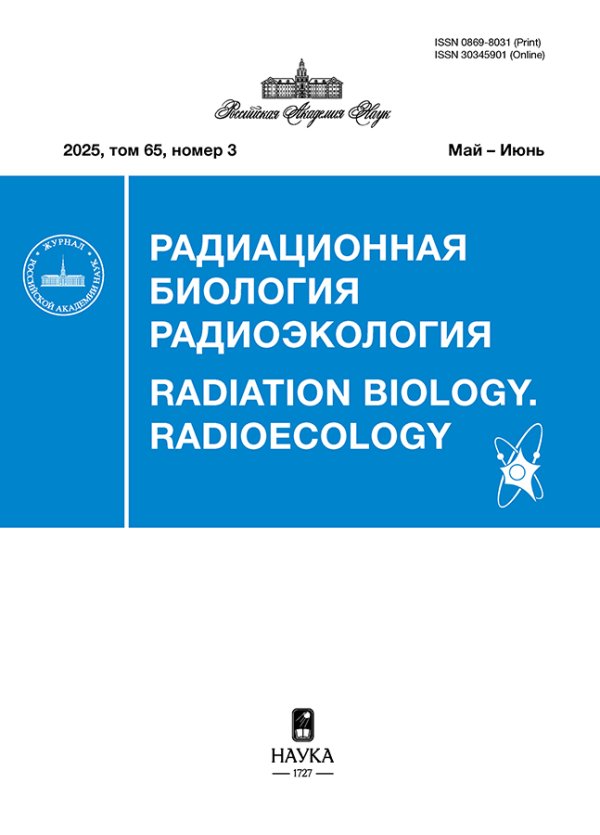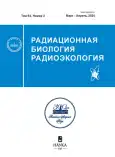Characteristics of the Cohort of Personnel of the Sublimate Production of the Siberian Chemical Plant Involved in Working with Plutonium-239
- Authors: Kalinkin D.E.1,2, Gorina G.V.1, Litvinova O.V.1, Milto I.V.1,2, Takhauov A.R.1, Takhauova L.R.1,2, Samoilova Y.A.3, Trivozhenko A.B.3, Avkhimenko V.A.3, Takhauov R.M.1,2
-
Affiliations:
- Seversk Biophysical Research Center of the Federal Medical-Biological Agency
- Siberian State Medical University
- Siberian Federal Scientific Clinical Center of the Federal Medical-Biological Agency
- Issue: Vol 64, No 2 (2024)
- Pages: 172-178
- Section: Материалы VII Международной научно-практической конференции “Медицинские и экологические эффекты ионизирующего излучения” (Томск, 21–22 марта 2023 г.)
- URL: https://transsyst.ru/0869-8031/article/view/661092
- DOI: https://doi.org/10.31857/S0869803124020065
- EDN: https://elibrary.ru/NBESRN
- ID: 661092
Cite item
Abstract
239Pu has the property of initiating radiogenic diseases in workers who come into contact with it during their professional activities. To study adverse medical and biological effects and to study in detail the potential consequences of plutonium exposure on the body of personnel at nuclear energy facilities, it is necessary to form a cohort of people involved in working with this isotope. The purpose of the study is to form and characterize a cohort of Siberian Chemical Plant sublimation production employees involved in working with 239Pu in the period 1953–2000. The source of information for forming the cohort was the database of the regional medical and dosimetric register of the population of closed administrative-territorial formation Seversk and the personnel of the Siberian Chemical Plant, containing personal, dosimetric, medical and biological information regarding all current and former employees of the Siberian Chemical Plant (about 65,000 people) since the founding of the enterprise till now. As part of this work, a cohort of sublimation production employees involved in working with 239Pu 9 in 1953–2000 was formed (1,052 people, 577 men and 475 women). The dosimetric, medical and biological characteristics of workers included in the sublimation production cohort are given. The created sublimation production cohort will make it possible to conduct comprehensive retrospective and prospective epidemiological studies to assess the morbidity and mortality of nuclear energy facilities employees, as well as to draw scientifically based conclusions regarding the role of 239Pu in the initiation of the most important socially significant non-infectious diseases (for example, malignant neoplasms, diseases of the circulatory system etc.) and mortality from these diseases. The scientific data obtained as a result of this study will make it possible to determine the main directions for organizing a system for assessing risks to the health of personnel at sites for the decommissioning of nuclear facilities and the formation of a set of measures aimed at improving the health-saving system of nuclear facilities employees and extending their working longevity.
Keywords
Full Text
About the authors
Dmitry E. Kalinkin
Seversk Biophysical Research Center of the Federal Medical-Biological Agency; Siberian State Medical University
Author for correspondence.
Email: kalinkin750@gmail.com
ORCID iD: 0000-0002-6948-6075
Russian Federation, Seversk; Tomsk
Galina V. Gorina
Seversk Biophysical Research Center of the Federal Medical-Biological Agency
Email: gorina.gal@mail.ru
ORCID iD: 0009-0004-7019-6843
Russian Federation, Seversk
Olesya V. Litvinova
Seversk Biophysical Research Center of the Federal Medical-Biological Agency
Email: litvinovaspiridonova@mail.ru
ORCID iD: 0009-0003-5395-4297
Russian Federation, Seversk
Ivan V. Milto
Seversk Biophysical Research Center of the Federal Medical-Biological Agency; Siberian State Medical University
Email: milto_bio@mail.ru
ORCID iD: 0000-0002-9764-4392
Russian Federation, Seversk; Tomsk
Anas R. Takhauov
Seversk Biophysical Research Center of the Federal Medical-Biological Agency
Email: Anas.t@inbox.ru
ORCID iD: 0000-0001-8712-5815
Russian Federation, Seversk
Liliya R. Takhauova
Seversk Biophysical Research Center of the Federal Medical-Biological Agency; Siberian State Medical University
Email: tahauovaa@gmail.com
ORCID iD: 0000-0002-6261-9795
Russian Federation, Seversk; Tomsk
Yulia A. Samoilova
Siberian Federal Scientific Clinical Center of the Federal Medical-Biological Agency
Email: samoilovaua@med.tomsk.ru
ORCID iD: 0009-0000-6407-7945
Russian Federation, Seversk
Alexandr B. Trivozhenko
Siberian Federal Scientific Clinical Center of the Federal Medical-Biological Agency
Email: borisah@yandex.ru
ORCID iD: 0000-0001-6449-9523
Russian Federation, Seversk
Viktor A. Avkhimenko
Siberian Federal Scientific Clinical Center of the Federal Medical-Biological Agency
Email: kb81@med.tomsk.ru
ORCID iD: 0000-0002-2178-601X
Russian Federation, Seversk
Ravil M. Takhauov
Seversk Biophysical Research Center of the Federal Medical-Biological Agency; Siberian State Medical University
Email: niirm2007@yandex.ru
ORCID iD: 0000-0002-1994-957X
Russian Federation, Seversk; Tomsk
References
- Определение содержания плутония-239 и обогащенного урана в моче при их совместном присутствии. Аналитическая инструкция. Институт биофизики МЗ СССР. М., 1977. 13 с. [Determination of the content of plutonium-239 and enriched uranium in urine when they are present together. Analytical instructions. Institute of Biophysics, USSR Ministry of Health. M., 1977. 13 p. (In Russ.)].
- Голутвина М.М., Садикова Н.М. Контроль за содержанием радиоактивных веществ в организме человека. М.: Атомиздат, 1979. 123 с. [Golutvina M.M., Sadikova N.M. Control over the content of radioactive substances in the human body. M.: Atomizdat, 1979. 123 p. (In Russ.)].
- Хохряков В.Ф., Суслова К.Г., Романов С.А., Востротин В.В. Легочный клиренс промышленных соединений плутония в отдаленные сроки после начала ингаляции. Мед. радиология и радиац. безопасность. 2000:45(2):28–34 [Khokhryakov V.F., Suslova K.G., Romanov S.A., Vostrotin V.V. Pulmonary clearance of industrial plutonium compounds in remote periods after the beginning of inhalation. Medical Radiology and Radiation Safety. 2000:45(2):28–34 (In Russ.)].
- Блинов А.П., Алпатов А.А., Горина Г.В. и др. Результаты исследования по выведению плутония из организма под воздействием пентацина при ингаляционном поступлении нуклида. Вопросы радиационной безопасности. 2020:2:55–65 [Blinov A.P., Alpatov A.A., Gorina G.V. et al. Analysis of pentacinum-assisted plutonium excretion at inhalation intake of the radionuclide. Radiation Safety Problems. 2020:2:55–65 (In Russ.)].
- Tirmarche M., Apostoaei I., Blanchardon E. et al. ICRP Publication 150: Cancer Risks from Plutonium and Uranium Exposure. Ann. ICRP. 2021;50(4):141–143. https://doi.org/10.1177/01466453211028020
- Хохряков В.Ф., Суслова К.Г., Востротин В.В., Романов С.А. Адаптация модели легочного клиренса МКРЗ–66 к данным о кинетике обмена плутония у персонала “Маяка”. Мед. радиология и радиац. безопасность. 2001:46(6):76–83 [Khokhryakov V.F., Suslova K.G., Vostrotin V.V., Romanov S.A. Adaptation of the ICRP–66 lung clearance model to data on plutonium metabolism kinetics in the ‘Mayak’ personnel. Medical Radiology and Radiation Safety. 2001:46(6):76–83 (In Russ.)].
- Khokhryakov V.F., Suslova K.G., Vostrotin V.V. et al. Adaptation of ICRP Publication 66. Respiratory tract model to data of plutonium biokinetics for Mayak workers. Health Phys. 2005:88(2):125–132. https://doi.org/10.1097/01.hp.0000144575.37546.9d
- Bess J.D., Krahenbuhe M.P., Miller S.C. et al. Uncertainties analysis for the plutonium dosimetry model, Doses–2005, using Mayak bioassay data. Health Phys. 2007:93 (3):207–219. https://doi.org/10.1097/01.HP.0000266741.42070.e8
- da Silva F.M.R. Júnior, Tavella R.A., Fernandes C.L.F., Dos Santos M. Genetic damage in coal and uranium miners. Mutat. Res.-Gen. Tox. En. 2021;866:503348. https://doi.org/10.1016/j.mrgentox.2021.503348
- Thandra K.C., Barsouk A., Saginala K. et al. Epidemiology of lung cancer. Contemp. Oncol. (Pozn). 2021;25(1):45–52. https://doi.org/10.5114/wo.2021.103829
- United Nations Scientific Committee on the Effects of Atomic Radiation (UNSCEAR): Sources and Effects of Ionizing Radiation. UNSCEAR 2006 Report to the General Assembly with Scientific Annexes. Volume I. Annex B: Epidemiological evaluation of cardiovascular disease and other non-cancer diseases following radiation exposure. ed. New York: UNSCEAR, 2008.
- United Nations Scientific Committee on the Effects of Atomic Radiation (UNSCEAR): Sources and Effects of Ionizing Radiation. UNSCEAR 2010 Report to the General Assembly with Scientific Report: Summary of Low-Dose Radiation Effects on Health. ed. New York: United Nations, 2013.
- Bouville A., Kryuchkov V. Increased occupational radiation doses: nuclear fuel cycle. Health Phys. 2014:106(2):259–271. https://doi.org/10.1097/HP.0000000000000066
- United Nations Scientific Committee on the Effects of Atomic Radiation (UNSCEAR): Sources and Effects of Ionizing Radiation. UNSCEAR 2008 Report to the General Assembly with Scientific Annexes. V. I. Annex B: Exposures of the Public and Workers from Various Sources of Radiation. ed. New York: UNSCEAR, 2010.
- National Research Council (NRC): Committee to Assess Health Risks from Exposure to Low Levels of Ionizing Radiation. Health risks from exposure to low levels of ionizing radiation. BEIR VII Phase 2. Washington, DC: NRC, National Academies Press, 2006.
- International Agency for Research on Cancer (IARC): Monographs on the evaluation of carcinogenic risks to humans. Ionizing radiation, part 1: X-ray and gamma-radiation, and neutrons. Lyon, France: World Health Organization, International Agency for Research on Cancer, 2000.
- International Agency for Research on Cancer (IARC): Monographs on the Evaluation of Carcinogenic Risks to Humans: Some Internally Deposited Radionuclides. International Agency for Research on Cancer ed., vol. 78. Lyon, France: World Health Organization, International Agency for Research on Cancer, 2001.
- Calabrese E.J., O’Connor M.K. Estimating risk of low radiation doses – a critical review of the BEIR VII report and its use of the linear no-threshold (LNT) hypothesis. Radiat. Res. 2014:182(5):463–474. https://doi.org/10.1667/RR13829.1
- Zablotska L.B., Ashmore J.P., Howe G.R. Analysis of mortality among Canadian nuclear power industry workers after chronic low-dose exposure to ionizing radiation. Radiat. Res. 2004:161(6):633–641. https://doi.org/10.1667/rr3170
- Howe G.R., Zablotska L.B., Fix J.J. et al. Analysis of the mortality experience amongst U.S. nuclear power industry workers after chronic low-dose exposure to ionizing radiation. Radiat. Res. 2004:162(5):517–526. https://doi.org/10.1667/rr3258
- Muirhead C.R., O’Hagan J.A., Haylock R.G. et al. Mortality and cancer incidence following occupational radiation exposure: third analysis of the National Registry for Radiation Workers. Br. J. Cancer. 2009:100(1):206–212. https://doi.org/10.1038/sj.bjc.6604825
- Gillies M., Richardson D.B., Cardis E. et al. Mortality from circulatory diseases and other non-cancer outcomes among nuclear workers in France, the United Kingdom and the United States. Radiat. Res. 2017:188(3):276–290. https://doi.org/10.1667/RR14608.1
- Hunter N., Kuznetsova I.S., Labutina E.V., Harrison J.D. Solid cancer incidence other than lung, liver and bone in Mayak workers: 1948–2004. Br. J. Cancer. 2013:109(7):1989–1996. https://doi.org/10.1038/bjc.2013.543
- Gillies M., Haylock R. The cancer mortality and incidence experience of workers at British Nuclear Fuels plc, 1946–2005. J. Radiol. Prot. 2014:34(3):595–623. https://doi.org/10.1088/0952-4746/34/3/595
Supplementary files











